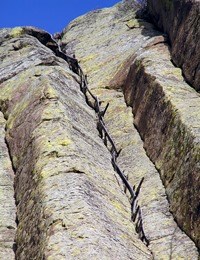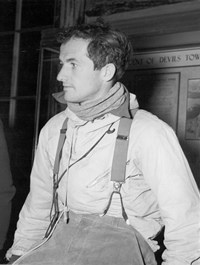
NPS photo Making History The first recorded climb of Devils Tower occurred over ten years before its establishment as a national monument. Willard Ripley and William Rogers were two ranchers living near the Tower in the 1890s. Working together, the two managed to construct a simple stake ladder which they used to climb to the Tower's summit. The feat was well promoted and drew spectators from as far as Rapid City, SD. As years went on an untold number of people used it to scale the Tower columns. But by the 1920s the ladder was in a state of serious disrepair. The bottom section has since been removed, with the top 200 feet restored by the park service in 1972. Visitors today can still see the old stake ladder - it is visible with the naked eye, but more easily spotted with binoculars or a good camera zoom. The story of the stake ladder has become a fascinating part of the park's cultural history. The ladder marks the beginning of a long history of climbing at Devils Tower. Although it was used by others after its construction, only a handful of stories survive. In 1937, a group of rock climbers sought to make history by scaling the sides without the use of a ladder. They would start a new tradition of climbing that still exists to this day. 
NPS photo Modern Climbers Prior to 1937, rock climbing was evolving as a sport in several places around Europe. Fritz Wiessner was a German-American climber and member of the American Alpine Club (based in New York). Climbing with Lawrence Coveney and William House, Wiessner led the trio in the first free climb of Devils Tower. Wiessner helped set the standard of rock climbing at the Tower, and his name is still attached to the route he and his cohorts pioneered in 1937. The story of the first free climb is available to read on the park website. The following year, Jack Durrance began the second expedition up the Tower columns. He studied the route Wiessner used the year before, and determined there could be a slightly easier option. What became known as the "Durrance Route" is today the most popular climbing route on the Tower. Considered by many to be the least difficult route, it still provides a challenge to experienced climbers scaling the Tower for their first time. Within a few years, Durrance would return to the Tower to climb it again. This next expedition would not be for recreation, however: Jack Durrance was leading a rescue mission. A Faster Way Up Throughout 1941, the eyes of the nation were fixed on the next "Great War." Europe and Asia were in turmoil, and many knew it was only a matter of time before the United States joined the fray. However the attention of the American people, and indeed those around the world, would be diverted for a short time in October 1941. The story of George Hopkins captivated people across the globe. A man had gotten himself stuck on the top of Devils Tower. How he got up there, why he could not get down, and what was being done to rescue him were conversation topics around many dinner tables. The parachutist drew a lot of attention to a little national monument in northeast Wyoming. In the end, Jack Durrance led a team of eight climbers to the summit to bring Hopkins down after being stranded for six days. |
Last updated: August 11, 2025
